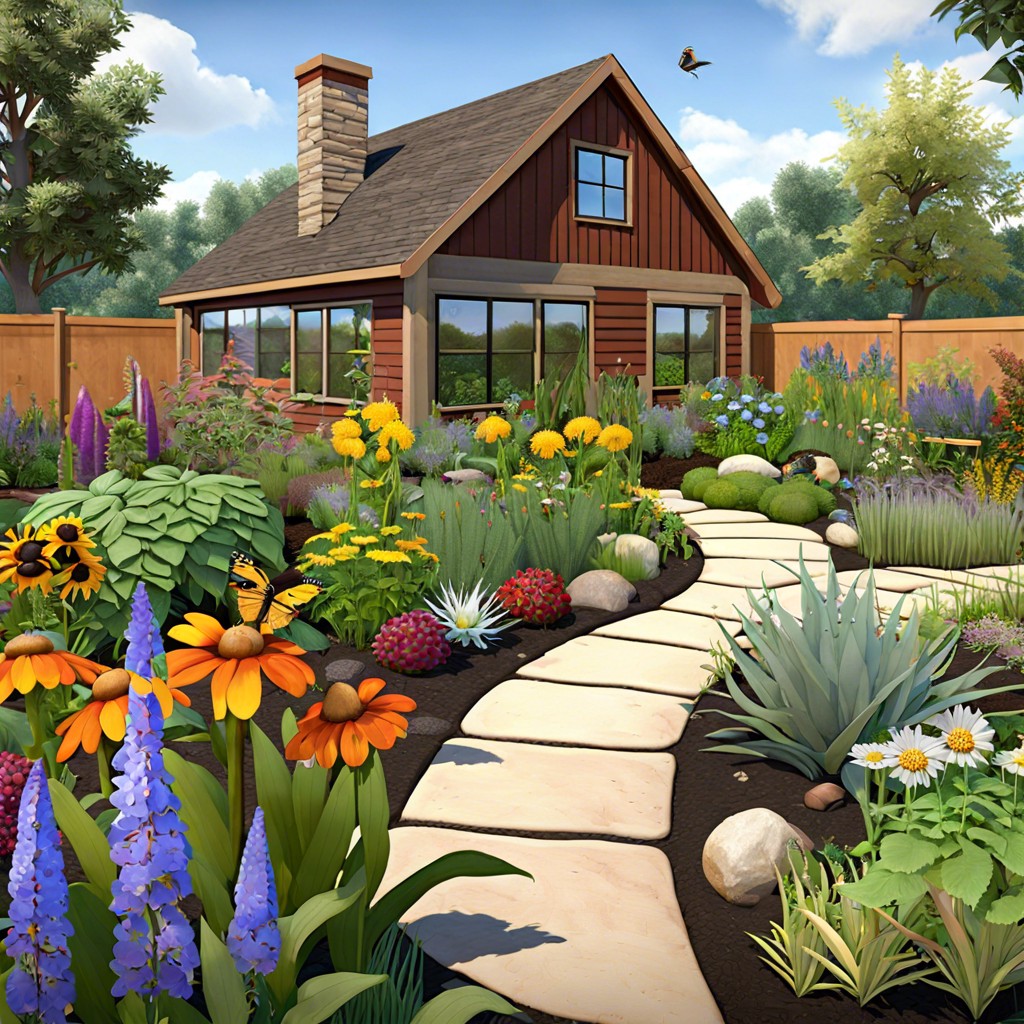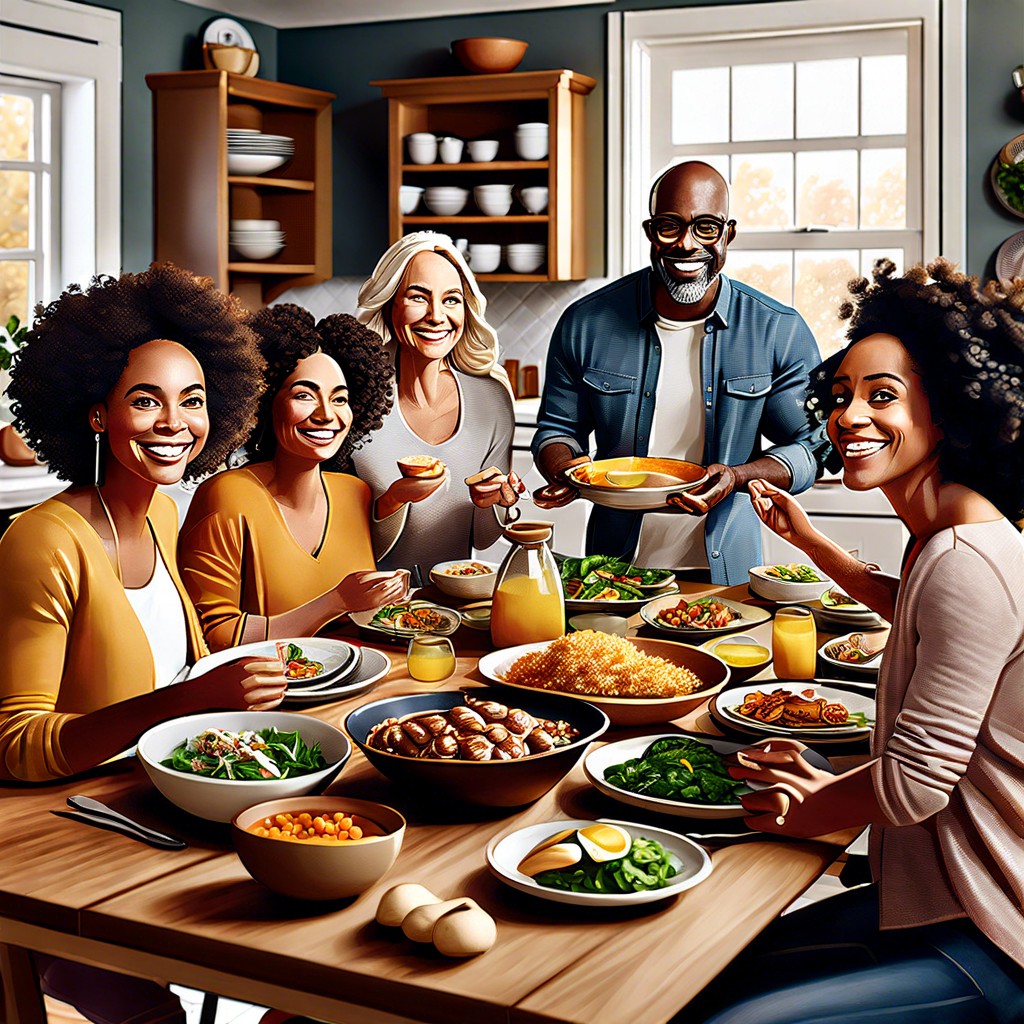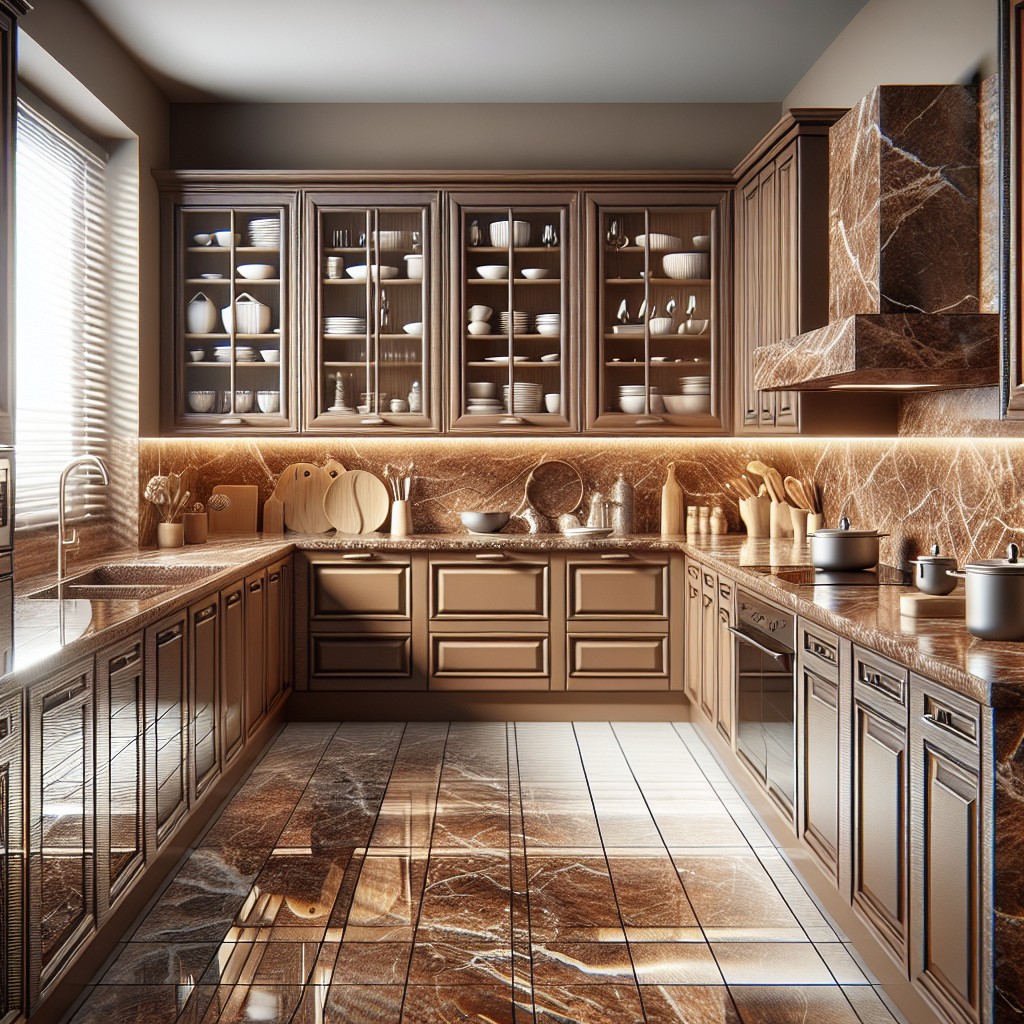Last updated on
Exploring the right cabinet colors with gray walls can substantially elevate your space by adding depth and contrast, because even the subtle nuances in hues can dramatically impact your room aesthetics.
Key takeaways:
- White or cream cabinets create a classic, bright aesthetic.
- Black cabinets offer a bold and modern look.
- Lighter gray cabinets create a seamless and spacious feel.
- Blue cabinets (powder, navy, cobalt) provide a serene or vibrant atmosphere.
- Red cabinets (coral, burgundy) add playfulness or elegance.
What's Inside
White or Cream Cabinets
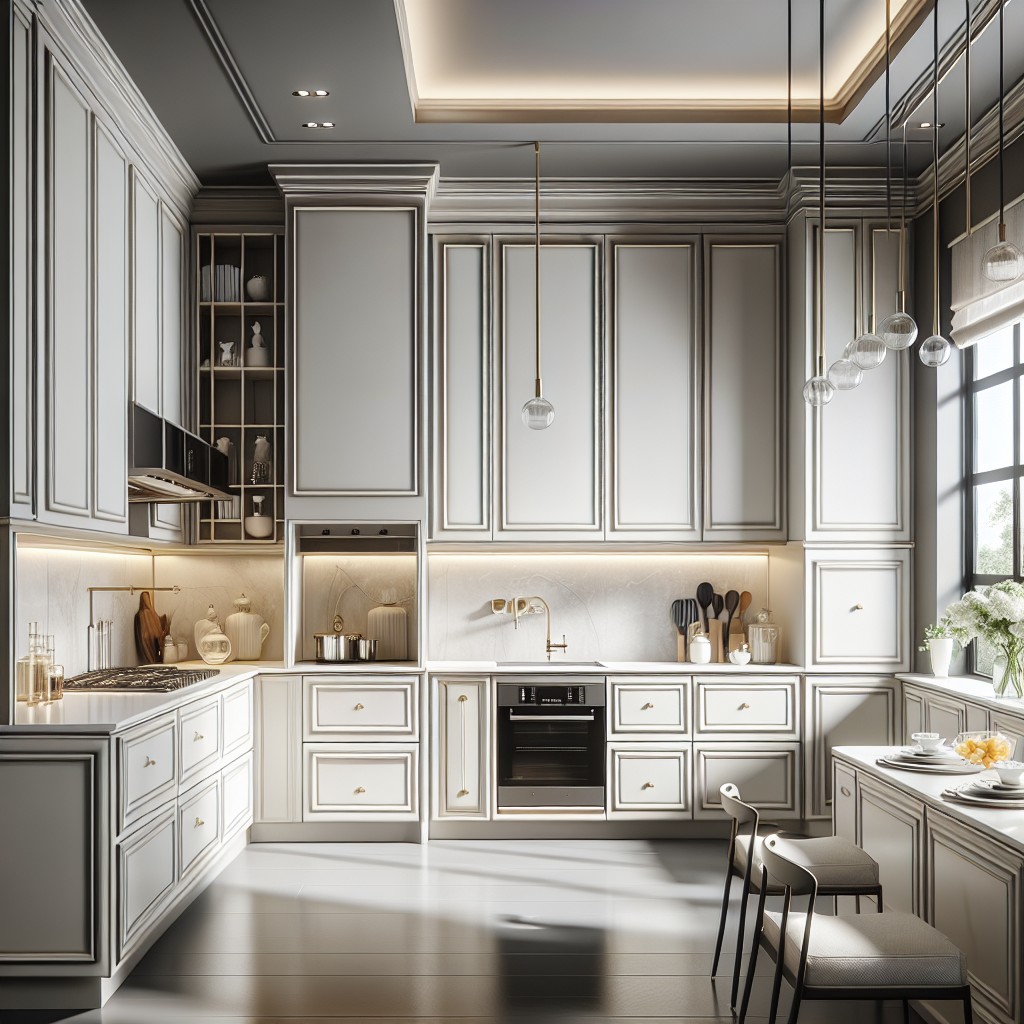
Pairing gray walls with white or cream cabinets creates a classic, timeless aesthetic that brightens the space and promotes a clean, airy atmosphere. The contrast between the light cabinetry and mid-tone walls can make both elements pop without overwhelming the room. This color combination works well in kitchens with limited natural light, as the lighter cabinets reflect more brightness into the area.
Incorporating white or cream also allows for versatility in decor choices. Whether aiming for a modern farmhouse look or sleek minimalism, these cabinet colors serve as a neutral background. They can accommodate bold hardware choices, from matte black to brushed brass, offering an additional layer of customization.
An important tip is to consider the undertone of your gray walls when selecting the shade of white or cream. Cooler grays pair well with crisp whites, while warmer grays complement creamier tones, ensuring a harmonious palette.
Adding textures such as subway tile backslashes or natural wood open shelving can introduce depth and keep the kitchen from feeling too stark. Accessorizing with plants or colorful kitchen appliances can also inject personality without permanence, offering the flexibility to adapt the kitchen’s look with the seasons or current trends.
Black Cabinets
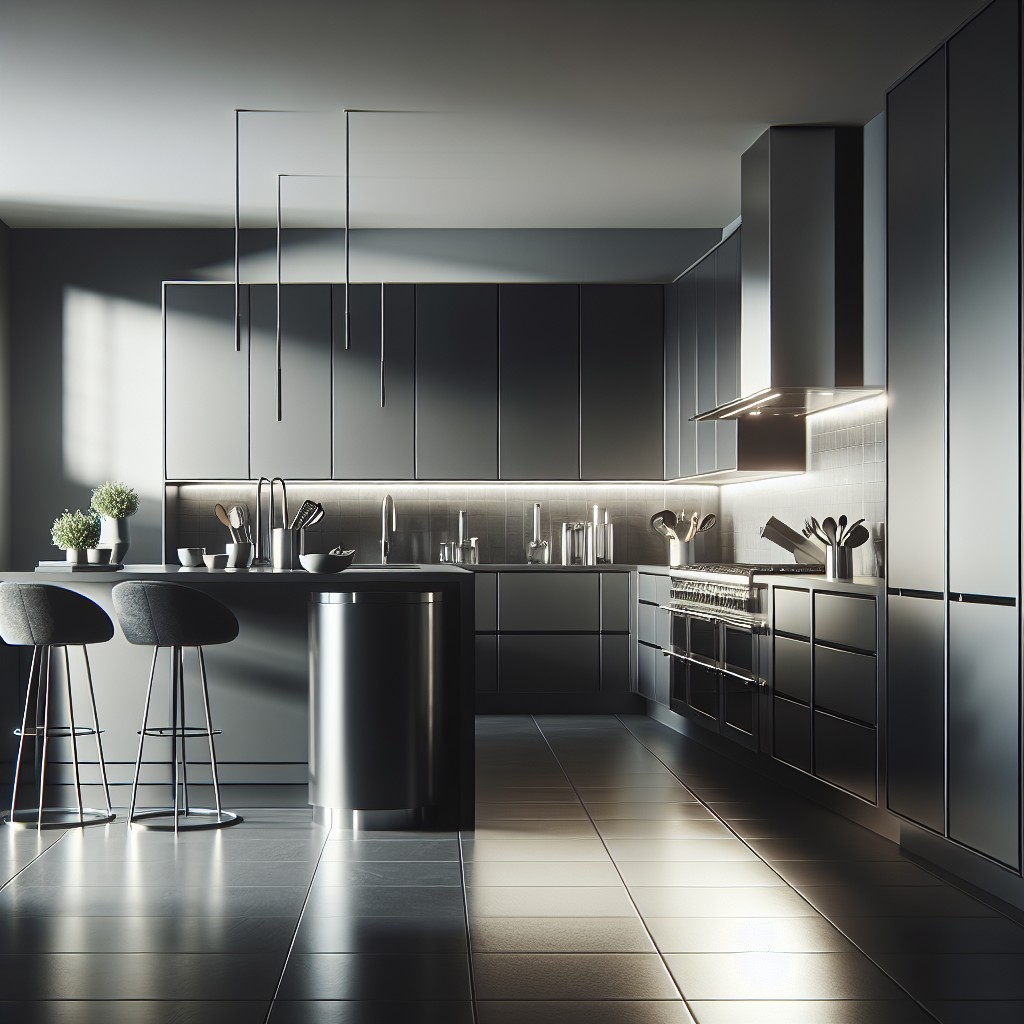
For a bold statement, black cabinets stand out against the neutrality of gray walls, offering a modern and sophisticated look. This color combination can work particularly well in spaces with ample natural light to prevent the room from feeling too dark.
Consider the following points:
- Finishes matter: Opt for a matte finish for a more contemporary feel, or high gloss to create a reflective surface that enhances light.
- Hardware choices: Silver or brushed nickel hardware can add a sleek touch, while brass or gold can warm up the space.
- Textural contrast: Introducing textures like a herringbone backsplash or open wooden shelving can break up the monochromatic scheme and add visual interest.
- Color temperature: Warm grays paired with black can create a cozy atmosphere, while cooler grays may evoke a more industrial vibe.
- Accent colors: Use pops of color in decorations or appliances for a dynamic layer that draws the eye and enlivens the space.
Lighter or Darker Gray Cabinets
When considering a monochromatic theme, play with different shades to add depth and dimension to your space. Opting for lighter gray cabinets can create a seamless flow and a subtle contrast that’s refreshingly modern and expands the perception of space. These are particularly effective in smaller kitchens where continuity is key to a spacious feel.
Conversely, darker gray cabinetry provides a striking visual anchor in the room, making a sophisticated statement. The depth of the dark cabinets against lighter gray walls draws the eye, giving a sense of luxury and groundedness. This combination works well in rooms with plenty of natural light or high ceilings, preventing the space from feeling too vast or impersonal.
In both cases, the key is to maintain a few degrees of separation between the wall color and cabinet hue, ensuring each can stand distinct without a jarring disconnect. Use textures and finishes—think matte versus glossy—to enhance the visual appeal and layer the room with interest.
Blue Cabinets: Powder, Navy, Cobalt
Adding a dash of blue to cabinetry against gray walls brings a serene yet sophisticated atmosphere to your space. Lighter shades like powder blue offer a soft, calming vibe, making it perfect for cottage or country-style kitchens. The gentle contrast it creates with gray walls is pleasing to the eye, providing a tranquil environment.
In contrast, navy blue introduces boldness and depth, acting as a statement piece in your kitchen. It complements the cool tones of gray walls while offering a luxurious and elegant feel to the room. This shade is excellent for those aiming for a more formal or nautical-themed kitchen.
For a more vibrant and energetic space, cobalt blue is the go-to choice. It pops against the neutrality of gray, infusing life and personality into the room. This electric shade works well with modern or eclectic decors and is sure to be a conversation starter.
Regardless of the shade, blue cabinets can be paired with various hardware finishes. Matte black or brushed nickel complements darker blues for a grounded look, while polished chrome or brass can accentuate lighter blues for a more luminous appeal. When selecting blue tones for your cabinets, consider the mood you wish to create and how it plays with the existing gray palette and natural light in your kitchen.
Red Cabinets: Coral, Burgundy
Coral cabinets breathe life into a kitchen, offering a playful yet sophisticated splash of color in a gray-dominated space. They work exceptionally well with soft, lighter grays, promoting a warm, inviting atmosphere. To ensure the look isn’t too vibrant, balance it with neutral accents and subdued hardware.
Opting for burgundy cabinets, on the other hand, adds a touch of timeless elegance and depth—ideal for creating a more formal or luxurious setting. These rich, dark red tones can serve as a striking contrast against mid-tone to light grays, carving out a visually dramatic space. For a cohesive design, consider incorporating brushed metal fixtures and soft, warm lighting that enhance the depth of burgundy without overpowering the room’s aesthetic.
Impact of Cabinet Color On Room Size and Light
The choice of cabinet color can significantly influence the perception of space and light in a kitchen with gray walls. Here’s how:
- Light-colored cabinets will reflect more light, enhancing a sense of spaciousness. White or cream options are ideal for making a smaller kitchen feel larger.
- Dark cabinets can create a dramatic contrast with light gray walls, but they may make a small room feel more enclosed. Well-placed lighting can mitigate this effect and add depth.
- Glossy surfaces on cabinets can bounce light around the room, while matte finishes absorb light, affecting the overall brightness.
- Using under-cabinet lighting with darker cabinetry can offset the potential for a gloomy atmosphere by illuminating workspaces.
- Mirrored or glass-front cabinet doors can amplify light, contributing to a lighter, airier feel in the kitchen space.
Each color and finish interacts uniquely with both natural and artificial light, shaping the room’s ambiance. Selecting the right balance ensures a harmonious, inviting kitchen environment.
Contrasting Cabinet Colors for Visual Interest
Contrasting colors create a striking visual effect that can breathe life into any kitchen space, especially when paired with gray walls. Opting for bold hues like cherry red or deep green can add a pop of color that draws the eye, serving as a focal point and adding character.
For a subtler contrast, consider pastel shades such as a soft teal or a blush pink that provide a gentle yet distinct differentiation from the gray. If you’re aiming for a sophisticated edge, navy or charcoal offer a sharp contradiction without overwhelming the room.
Remember, the key is to choose a cabinet color that not only stands out against the gray but also harmonizes with the overall design of your kitchen. When in doubt, test out cabinet color swatches in various lighting to see how they complement your gray walls at different times of the day.
Tips for Testing Cabinet Colors With Gray Walls
Before committing to a cabinet color, consider a few strategic approaches to ensure compatibility with your gray walls:
1. Sample Swatches: Use large swatches of potential cabinet colors in the actual room. Observe them at different times of day to see how varying light conditions affect the appearance.
2. Temporary Wallpaper or Vinyl Sheets: Apply temporary materials on a section of your cabinets. They mimic the actual color and can be removed easily, helping you visualize the final look without permanent changes.
3. Digital Mockups: Employ software or apps that can simulate different cabinet colors in your kitchen space. This approach offers a risk-free way to play around with various hues.
4. Consult a Color Wheel: A color wheel helps identify complementary shades for your gray walls. Look for colors directly opposite gray to find appealing contrasts.
5. Professional Advice: Sometimes, a professional designer can offer insights into color trends and timeless combinations, potentially preventing a choice you might regret later.
6. Consider Undertones: Gray can have warm or cool undertones. Make sure your cabinet colors harmonize with these undertones rather than clash.
7. Accessorize Wisely: Pair potential cabinet colors with hardware and accessories you plan to use. This gives a more comprehensive view of the aesthetic.
Remember, these strategies aim to give you confidence in your color choice, creating a cohesive look that suits your style and home.
Pairing Countertops With Gray Walls and Cabinet Colors
When choosing countertops, harmony with your cabinet and wall colors is key. Opt for light-colored countertops to brighten the space if your cabinets are dark. Classic choices include white marble or light granite, which offer a clean, timeless look. Conversely, with white or light cabinetry, consider darker countertops for a striking contrast; think black granite or quartz with subtle gray veining.
If your cabinets are in shades of blue or red, a neutral countertop can serve as a balancing feature. Warm-toned wooden countertops or cool concrete can create an appealing juxtaposition while anchoring the overall aesthetic. For a contemporary edge, stainless steel or zinc counters reflect light and add an industrial chic that complements gray walls without overwhelming the senses.
Textures and patterns in countertops are also crucial; a simple, solid color can set a serene tone, whereas bold veining or speckled patterns inject dynamism. Ensure samples are viewed in the actual room lighting, as colors and textures may shift under different conditions.
Finally, consider the finish – polished surfaces offer shine and sophistication, while honed or leathered finishes impart a more muted, organic feel. Balancing aesthetics, durability, and maintenance will result in a cohesive and stunning kitchen composition.
Maintaining Balance Between Wall and Cabinet Colors
A harmonious kitchen space is achieved through the delicate balancing of wall and cabinet colors. Here are some tips:
- Choose a cabinet color that complements the undertones in your gray walls. Warm grays pair well with similarly warm hues, while cool grays blend with cooler tones.
- If opting for a monochromatic look, vary the saturation. Pair light gray walls with deep charcoal cabinets, or vice versa, to create depth without overwhelming the space.
- When working with vibrant cabinet colors, incorporate elements of gray from the walls into your backsplashes or accessories to create a cohesive design.
- Use a color wheel to find complementary colors if you’re aiming for a bold contrast. Colors opposite gray can provide a striking balance.
- Consider the room’s natural and artificial lighting, as this can significantly affect the way colors appear and interact with one another.
- Mind the visual weight of your chosen colors; lighter colors tend to make spaces feel larger, while darker shades add coziness but may make a room feel smaller.
- Lastly, integrate metals and woods in your hardware and furnishings to add warmth and texture, ensuring your colors don’t feel flat or one-dimensional.
FAQ
What color of cabinets go with gray walls?
White cabinets are an excellent choice to pair with gray walls, offering contrast and brightening the room.
What color cabinets go with agreeable gray walls?
Agreeable gray walls perfectly match with cabinets painted in colors like Alabaster, Sea Salt, Mega Greige, Brainstorm Bronze SW 7033, Basil SW 6194, or Dovetail 7018.
What color goes best with gray for a kitchen?
When aiming for a cohesive kitchen aesthetic, colors that pair best with gray include white, light gray, beige, taupe, blue, and green.
What color wood goes with gray walls?
Light to medium brown wood such as walnut, pine, and medium brown varieties compliment grey walls effectively, with darker grey walls particularly favoring lighter tone woods.
What color kitchen islands complement gray walls?
Kitchen islands in colors such as white, navy blue, or earth tones like warm browns and greens can greatly complement gray walls.
How does a gray wall influence the selection of cabinet hardware colors?
A gray wall allows flexibility in selecting cabinet hardware colors, making silver, gold, and black tones suitable choices due to its neuter color spectrum.
What shade of gray walls work best with white kitchen cabinets?
Light-to-medium shades of gray work best with white kitchen cabinets for a balanced and contemporary look.
